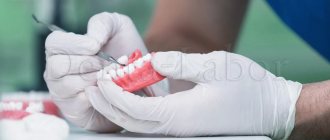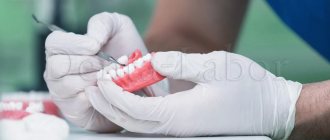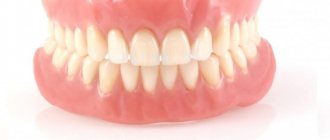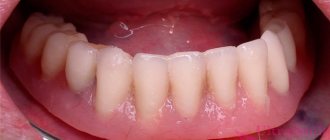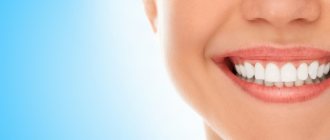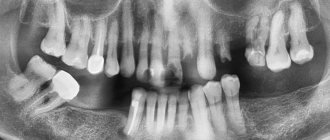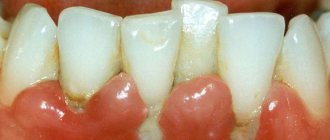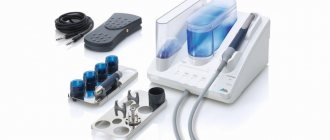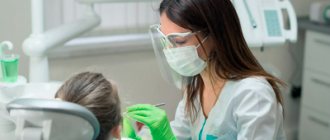Indications for relining Correction methods Relining materials Where to do it?
The basis for comfortable use of removable orthopedic systems is a reliable fit to the jaw. But gradually the fixation of the structure weakens, functionality decreases, and discomfort appears when eating and talking. Relining a denture (partial, complete) – involves eliminating inaccuracies, preventing damage to the base of the structure, restoring precise contact with the gums and supporting dental units. Depending on the clinical case, such a procedure is performed in the dentist’s office or in a laboratory setting.
When is denture relining necessary?
After fixing the new orthopedic system, after the first 1-3 months
wearing, relining the denture is necessary to correct the accuracy of its fit to the mucosa. Because the teeth were missing for some time, the jaw joint was rebuilt. After installing the prosthetic structure, the load on the jaw tissue changes. It begins to gradually atrophy, the gums sag, and the bite begins to change. The prosthesis becomes uncomfortable and the occlusion is disrupted.
Relocation shown:
- if the structure does not hold well in the mouth, falls out during conversation, eating, or puts pressure on the gums;
- in the presence of defects in the prosthetic system due to violations of technology during impression taking or manufacturing;
- deterioration of the aesthetic characteristics of the structure;
- the prosthesis has been damaged or has flaws;
- the shape of the alveolar process has changed, which caused instability of the orthopedic structure;
- an atypical change in the height of the lower part of the face was detected (even if the deviation is minimal from the original parameters).
Correction is needed not only for removable models, but also for conditionally removable structures supported by implants. Mostly, these are single-stage protocols with instant load (all-on-4, all-on-6). After implantation of implants and installation of a prosthetic system, the load on the bone increases. This leads to enhanced regeneration of bone tissue and an increase in its parameters, which requires correction of the orthopedic apparatus. That is, if the bite changes, the position of the prosthetic system changes.
Some tips for wearing new dentures
- Chew food alternately on both sides! This will help the prosthesis take its place and minimize the risk of the prosthesis being thrown off the valve area.
- When you bite off solid food using your puller, it is better to use the canines and premolars rather than the incisors, biting as if sideways. Most often, the lateral teeth are located in a more central position in the prosthesis, and the dental technician moves the incisors slightly forward for greater beauty. This is more beautiful, but when biting, tearing moments occur and the prosthesis pushes out of its place.
- At first, avoid eating apples, carrots, and generally solid foods.
- Diction will change; at first, some sounds will not be pronounced. You need to give your tongue time to get used to the changes in your mouth. It is possible that some words and sounds will sound strange when spoken, especially the sounds of the letters “n”, “r”, “z”. But as you well know, only practice makes perfect! The more often you talk or read out loud, the faster you will start talking like you used to.
- To clean dentures, use tooth powder and a denture or hand brush. They are longer and wider, the bristles are denser, and cleaning the prosthesis will be quick. You can, of course, use a toothbrush, but its cleaning effect for plastic is insufficient, cleaning two dentures will take a lot of time, do not forget that you also need to clean the oral cavity.
Caring for removable dentures to prevent complications such as chronic inflammation of the mucous membrane
First of all, dentures should be thoroughly cleaned of all kinds of deposits. Oddly enough, most of the dentures in patients who complained of redness of the gums and pain had plaque on the dentures. Nobody is saying that people don't brush their artificial teeth. But, obviously, they do it quite quickly, as a routine procedure.
Meanwhile, it should be noted that the surface of the prosthesis is curved and has depressions. A protein film accumulates in them, which hardens over time, and then begins to grow in thickness and area. It is very difficult to remove hardened deposits from plastic; sometimes you have to do this with a carborundum head, grinding through each depression, and before doing this, soak the dentures in hydrogen peroxide. But it is this plaque that causes gum inflammation.
Therefore, the patient must independently ensure that this protein film does not form. Once a week, the denture should be carefully inspected, especially the recesses where the cleaning brush may not penetrate. If plaque is found, you need to remove it with a gauze cloth with a cleaning agent and tooth powder or soda. You need to rub quite vigorously, and fix the result by polishing with toothpaste.
Denture cleaning tablets are sold.
However, both tablets and hydrogen peroxide do not remove the protein film itself, but only discolor and inactivate it. [email protected] Samara, Industrial district st. Novo-Vokzalnaya, 269 +7
Correction methods
Relining a complete removable denture, as well as restoring a partial structure, is carried out by two methods - clinical (in the dentist's office) and laboratory. If the design does not fit well enough, the doctor will be able to adjust it in front of the patient; this takes a minimum of time. If there is a significant violation of the fit, or a decrease in the height of the bite, additional equipment will be needed; correction is carried out in a laboratory. How dentures are relined depends on the complexity of the work and the type of prosthetic system.
Clinical method
The procedure includes the following stages of prosthesis relining:
- assessment of bite, occlusion, compliance of the orthopedic design with the jaw relief;
- adjusting the structure, filing edge elements (lengthening, shortening);
- removal of polishing from the orthopedic system, preparation of the polymer mass;
- distribution of the polymer composition onto the treated surface of the prosthesis;
- installation of an orthopedic system for the patient, with complete closure of the teeth of the upper and lower jaw (assessment of central occlusion);
- removal of excess polymer mass from the structure, polymerization of plastic (if there is a metal base, a layer of the corresponding metal is sprayed onto the inner surface of the prosthesis, then a plastic mass is applied to the metal base);
- immersion in hot water for final polymerization, improving adhesion strength;
- modeling of the edge segment, finishing polymerization.
The clinical method allows you to immediately eliminate all shortcomings and achieve a tight fit of the prosthetic system to the gums. The technique is not used in the presence of infectious and inflammatory diseases of the oral mucosa or allergies to plastic.
Laboratory method
Relining the prosthesis base in the laboratory allows you to avoid the negative impact of the plastic composite on the mucous membrane, but you will have to wait several days for the result.
- The doctor assesses the condition of the prosthetic structure, takes an impression of the patient’s teeth and sends everything to the laboratory;
- a thin layer of plastic is removed from the orthopedic system, the polishing is removed from the edge segment;
- the required amount of plastic is applied to the structure, its boundaries are formed, ground, polished, and the closure in the position of central occlusion is checked;
- the finished orthopedic system is returned to the doctor, who installs it for the patient.
Among the advantages of the technique are high aesthetics of the prosthetic system, maximum adhesion of materials (base, relining polymer), and absence of allergies to the plastic composite. Relining plate dentures in the laboratory takes 2 days or more
. There is no adaptation to the adjusted orthopedic device, since the patient has already used it before.
How to do this without a doctor?
A first aid remedy can be KAMISTAD GEL, produced in Germany, anesthetizes the wound, as it contains lidocaine. It also promotes healing.
Solcoseryl is a dental adhesive paste that promotes wound healing and relieves pain, made in Switzerland.
If you do not have the opportunity to sharpen a removable denture, METROGYL DENTA, made in India, has an antiseptic and ANTI-MICROBIAL effect.
It is possible to combine KAMISTAD + METROGYL DENTA or SOLCOSERYL + METROGYL DENTA
If in a removable denture you find and remove as quickly as possible, sharpen the part that is pressing, then ANESTHEATH and ANTIMICROBIAL components will not be needed.
As a rule, even the most severe cuts in the cavity heal quickly once the cause of the injury is eliminated!
Types of relining material
Correction of removable laminar dentures involves the use of the following materials:
- Hard plastic
– cold-curing acrylics (Protacryl, Redont), hot-curing acrylates (Ethacryl, Ftorax, etc.), polymethyl methacrylate. Solid base plastics are used for rigid fixation of orthopedic systems or laboratory relocation. - Soft composites
– acrylic, silicone elastomers. It is used if the physical parameters of the orthopedic device are normal, but the patient experiences headaches and discomfort. Typically used for relining mandibular prosthetic structures. - Temporary elastics
(conditioners) – polyvinyl chlorides and silicone base materials are highly elastic and are used for soft relining of dentures in case of systematic inflammation of the gums. Elastic materials are characterized by particular softness and are intended to reduce and uniformly redistribute chewing pressure to sensitive areas of the mucosa. Temporary material should be regularly updated, as it reacts negatively to cleaning agents and is susceptible to the accumulation of bacterial plaque.
The cost of relining an orthopedic system depends on several parameters - the technology used, material, type (clasp, conditionally removable, removable), size of the prosthesis, etc.
Types and prices of removable dental prosthetics
The main types of prosthetics in dentistry “Zubastic”:
- “ Butterfly ” - the prosthesis replaces 1-2 missing units.
- Removable denture (partial) - recommended for incomplete edentia. This design prevents mobility and displacement of the remaining teeth and ensures chewing function.
- Complete removable dentures on implants are the latest method of restoring lost teeth. Implants serve as support for the plate prosthesis. The method is used for complete edentia. Strengthening (fixation) of the bridge occurs due to spherical abutments. The patient can independently remove the prosthesis for hygiene procedures.
- The clasp is a structure on a metal frame to which a base with artificial teeth is welded. This is one of the best options for removable dentures, which evenly distributes the chewing load, is characterized by increased strength and comfort of use.
The price for removable dental prosthetics in Moscow at Zubastik clinics is low. The doctor will suggest an option for restoring the dentition after examining and assessing the condition of the remaining teeth.
Where to contact
Patients with removable orthopedic devices are recommended to see an orthopedist every 6 months
for relocation of the structure. This must be done for preventive purposes, since due to a violation of the fixation of the orthopedic system in the mouth, breakage of the structure, rapid loosening and loss of supporting teeth (with partial structures) may occur.
To restore a prosthesis in Moscow, it is most convenient to contact the RUTT network of clinics. Relining is carried out using modern cushioning materials from reliable manufacturers, which guarantees precise fit of the restored structure, uniform distribution of the chewing load, and long service life.
Expert of the article Alekperov Roman Borisovich Dentist-orthopedist, doctor of the first category
Work experience24 years
Materials for removable dental prosthetics
Materials used for the manufacture of dentures in dentistry “Zubastic”:
- Acrylic – dentures made from acrylic plastic are strong and durable.
- Nylon is an elastic, flexible and lightweight material. A nylon product is more comfortable to wear, but the soft texture does not provide an even chewing load.
- Acry-free is a modern option that combines the flexibility of nylon and the strength of acrylic. Products made from it are comfortable and aesthetically pleasing.
The specialist will select the material and method of fastening individually, taking into account the existing defect, jaw structure and other factors.
Symptoms that require immediate medical attention
Dentures can be uncomfortable from the start. This may be caused by its incorrect manufacture, or simply by discomfort caused by the appearance of a foreign object in the oral cavity. In the first days, it is strongly recommended not to remove the structure so that you can get used to it, so that all the mucous membranes adapt. But if the pain intensifies, the gums become inflamed and it is really impossible to wear a denture, you should consult a doctor.
System correction is also necessary in the following situations:
- Bite disturbances occur when the jaws are closed, regardless of how many dentures are installed - only on one jaw or on both jaws at once,
- It’s impossible to chew with new teeth – it’s uncomfortable and even painful,
- ulcers form on the gums under the structure, the gums bleed,
- there is continuous and painful contact of the prosthesis with the mucous membranes - the inside of the lips and cheeks,
- the structure does not hold, it shifts under load,
- burning of the mucous membrane, severe dry mouth, rash in the oral cavity.
Doctors' opinions on removable dentures
Modern dentistry has advanced significantly. Today, prosthetics with removable clasp and other types of prostheses are viewed more as a temporary measure. It is advisable to install such dentures even if there are contraindications to wearing fixed products or performing dental implantation.
Doctors advise installing structures for adults and children who have lost teeth in order to prevent the displacement of dental units. In pediatric dentistry, such devices prevent the development of malocclusion pathologies and other problems associated with the premature loss of baby teeth.
Obviously, this type of prosthesis deserves attention in certain clinical cases. Sometimes removable products become the only real opportunity to restore lost teeth, and with them the opportunity to live a full life.
Stages of complete removable dentures
Stages of work of a dentist and dental technician:
- Preparation for removable prosthetics (sanitation of the oral cavity);
- Taking impressions;
- Casting a plaster model of the jaw;
- Making a temporary prosthesis on a wax base;
- Trying on, making necessary changes;
- Replacing wax with the selected material (acrylic, nylon);
- Installation of the prosthesis, adjustment, grinding, grinding of the base.
After all manipulations are completed, the dentist gives recommendations on how to care for the dentures.
